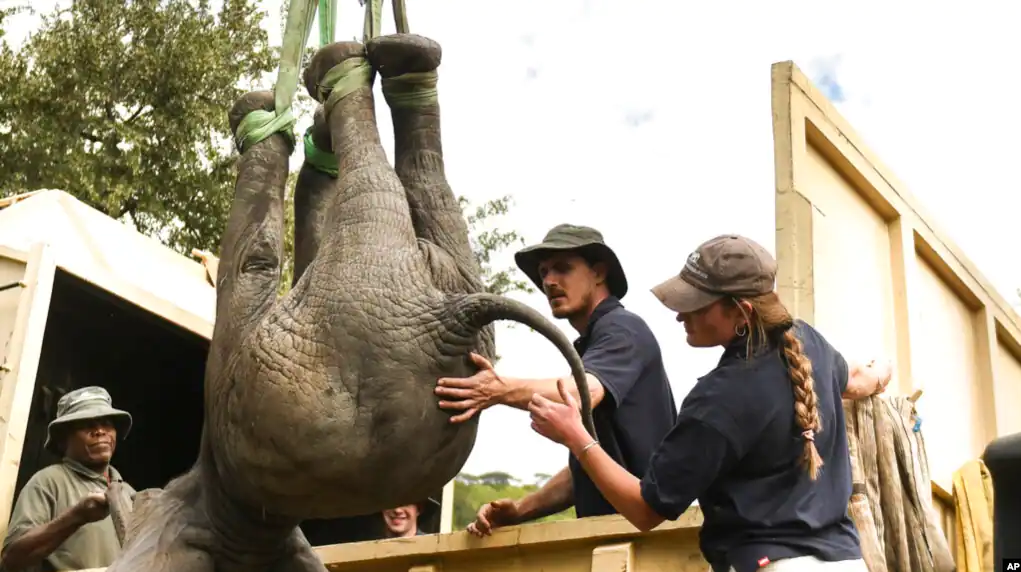 hadhwanaag
hadhwanaag
A helicopter herds
thousands of impalas into an enclosure. A crane hoists sedated upside-down
elephants into trailers. Hordes of rangers drive other animals into metal cages
and a convoy of trucks starts a journey of about 700 kilometers to take the
animals to their new home.
Zimbabwe has begun
moving more than 2,500 wild animals from a southern reserve to one in the
country’s north to rescue them from drought, as the ravages of climate change
replace poaching as the biggest threat to wildlife.
About 400 elephants,
2,000 impalas, 70 giraffes, 50 buffaloes, 50 wildebeest, 50 zebras, 50 elands,
10 lions and a pack of 10 wild dogs are among the animals being moved from
Zimbabwe’s Save Valley Conservancy to three conservancies in the north — Sapi,
Matusadonha and Chizarira — in one of southern Africa’s biggest live animal
capture and translocation exercises.
"Project Rewild
Zambezi,” as the operation is called, is moving the animals to an area in the
Zambezi River valley to rebuild the wildlife populations there.
It’s the first time in
60 years that Zimbabwe has embarked on such a mass internal movement of
wildlife. Between 1958 and 1964, when the country was white-minority-ruled
Rhodesia, more than 5,000 animals were moved in what was called "Operation
Noah.” That operation rescued wildlife from the rising water caused by the
construction of a massive hydro-electric dam on the Zambezi River that created
one of the world’s largest man-made lakes, Lake Kariba.
This time it’s the lack
of water that has made it necessary to move wildlife as their habitat has
become parched by prolonged drought, said Tinashe Farawo, spokesperson for the
Zimbabwe National Parks and Wildlife Management Authority.
The parks agency issued
permits to allow the animals to be moved to avert "a disaster from happening,”
said Farawo.
"We are doing this to
relieve pressure. For years we have fought poaching and just as we are winning
that war, climate change has emerged as the biggest threat to our wildlife,”
Farawo told The Associated Press.
"Many of our parks are
becoming overpopulated and there is little water or food. The animals end up
destroying their own habitat, they become a danger unto themselves and they
encroach neighboring human settlements for food resulting in incessant
conflict,” he said.
One option would be
culling to reduce the numbers of wildlife, but conservation groups protest that
such killings are cruel. Zimbabwe last did culling in 1987, said Farawo.
The effects of climate
change on wildlife is not isolated to Zimbabwe. Across Africa, national parks
that are home to myriad wildlife species such as lions, elephants and buffaloes
are increasingly threatened by below-average rainfall and new infrastructure
projects. Authorities and experts say drought has seriously threatened species
like rhinos, giraffes and antelopes as it reduces the amount of food available.
For example, a recent
study conducted in South Africa’s Kruger National Park linked extreme weather
events to the loss of plants and animals, unable to cope with the drastic conditions
and lack of water due to longer dry spells and hotter temperatures.
The mass movement is
supported by the Great Plains Foundation, a non-profit organization that works
"to conserve and expand natural habitats in Africa through innovative conservation
initiatives,” according to its website. The organization is working with the
Zimbabwe National Parks and Wildlife Management Authority, local experts, the
University of Washington-Seattle’s Center for Environmental Forensic Science
and Oxford University’s Department of Zoology, according to the website.
One of the new homes
for the animals moved in Zimbabwe is Sapi Reserve. the privately run
280,000-acre private concession is east of Mana Pools National Park, a UNESCO
World Heritage Site known for its splendid setting along the Zambezi River that
forms the border between Zimbabwe with Zambia.
Sapi "is the perfect
solution for many reasons,” Great Plains Chief Executive Officer Dereck Joubert
said on the foundation’s website.
"This reserve forms the
middle-Zambezi biosphere, totaling 1.6 million acres,” wrote Joubert. "From the
1950s until we took it over in 2017, decades of hunting had decimated wildlife
populations in Sapi Reserve. We are rewilding and restoring the wild back to
what it once was.”
VOA
Hadhwanaagnews marnaba masuul kama aha Aragtida dadka kale. Qoraaga ayaa xumaanteeda, xushmadeeda iyo xilkeeda sida. waxa kaliya oo Hadhwanaagmedia dhiirigalinaysaa, isdhaafsiga aragtida, canaanta gacaliyo talo wadaagga!